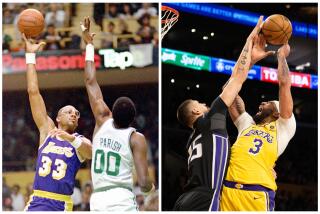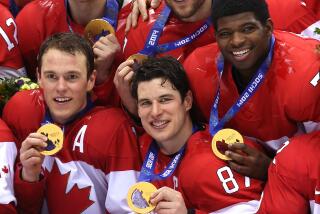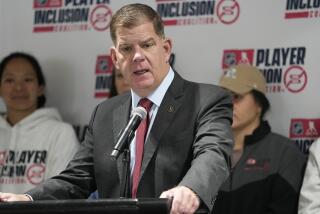Put Safety, Not Machismo, First
- Share via
One day after Mighty Duck prospect Jordan Smith was struck by a deflected puck during a minor-league game and lost the sight in his left eye, Duck forward Joffrey Lupul attached a visor to his helmet.
Lupul wore it in practice for a few days and didn’t use it in his first game after the Olympic break, but he has worn it every game since.
And he has come to believe that every NHL player should wear one.
“I always said, ‘It’s the player’s choice. It’s the player’s choice.’ But it’s bad for the game and the fans, seeing an injury like that,” said Lupul, who was briefly a teammate of Smith’s with Cincinnati of the American Hockey League during last season’s lockout.
“We lost a guy who was going to be part of our organization, and that’s the least of all the worries. Here’s a 20-year-old with his whole life ahead of him.”
It’s time for players to ignore the pseudo-macho code that denigrates those who wear visors.
It’s time to accept that players are bigger and stronger and shoot harder, thanks to technology that turns the weakest wrist shot into a cannon blast. That visors benefit players by prolonging their careers and protecting them for their post-hockey lives, while also protecting owners’ investments.
If players won’t agree to adopt visors immediately, fine. Grandfather them into use, as helmets were phased into the NHL for players who signed professional contracts starting in 1979.
But use them.
Please.
If he’d worn one, Mats Sundin wouldn’t have missed so much of the season because of an eye injury. Bill Guerin might not have needed surgery two weeks ago to repair a broken orbital bone. Bryan Berard might have become a Hall of Fame-caliber defenseman instead of a marginal player with limited vision.
Mike Barnett, general manager of the Phoenix Coyotes, has become a passionate advocate of phasing visors into use. It’s a personal crusade, born of remembering how he felt 30 years ago when a deflected puck hit him in the left eye and ended his career.
“You lay on the ice and close your good eye and you see nothing,” he said. “You close your good eye to find out how bad the bad one is. It’s a feeling you don’t want any player to experience.”
He says he respects the right of veteran players to choose whether to wear visors, but that they should be aware of the risks. Sticks are lighter and players swing them more carelessly, he said, and players shoot harder too.
“There’s absolutely no doubt the time is now for the players’ association to abandon its desire to let each player make a determination about what’s safe,” Barnett said. “Every player who comes into the league, there’s no reason to give them the option to take it off. If we don’t give them that option, in 10 years we will have a league of visors.”
This isn’t asking the impossible. Every player in junior hockey must wear a shield. Every player in college hockey must wear a full cage. Wearing that protection didn’t hold them back, yet many take their visors off when they turn pro.
“They’ve been pretty good players when they wore facial protection,” said Dave Andrews, president of the AHL.
“I understand certain players being of the opinion that they have the right to choose. It’s like seat-belt legislation: There are people who insist it’s their right not to wear one. On the other hand, the medical evidence is pretty strong that they should have it on. It’s pretty hard to accept the notion that Joe Sakic, Jarome Iginla or Peter Forsberg are somehow lesser players because they wear visors.
“This is a debate that needs to take place over the next little while.”
Craig Conroy of the Kings, who sat out two games last week after he was hit in the left eye by a deflected puck, wore a visor in college but removed it when he made his debut with the Canadiens.
“In Montreal, you just kind of looked at the veterans to see what they did. All the rookies had them off,” he said.
“It’s scary. Something bad could happen in a second. I was lucky.”
He’s wearing a visor, on doctor’s orders, but says he will probably remove it as soon as he’s permitted. “It’s just so different after not wearing it for so long,” he said. “I’ve always been one to think to each his own, but if they did grandfather visors in, it would be like helmets. Nobody would complain and people would, for the most part, go with it.”
Doug Wilson, general manager of the San Jose Sharks, was one of the last bareheaded NHL players. “That’s not a sign of genius,” he said wryly. He now believes that players entering the NHL should keep their visors on and has said so to the Shark players and to his son, Doug Jr., a junior hockey defenseman.
“This is a physical game, and we want it to be physical. But guys are keeping their sticks down in passing lanes and a lot of pucks are getting deflected and people are getting hurt,” Wilson said. “The game at its best has a lot of speed, flow and contact. Nobody wants to see people get hurt.”
The use of visors must be collectively bargained with the Professional Hockey Players’ Assn. at the minor league level, and the NHL Players’ Assn. The NHLPA has maintained that players should have the final say, but maybe Jordan Smith’s sad story will persuade union members otherwise. Or the story of Nick Fuher, a Coyote prospect who suffered a devastating eye injury in his third game as a pro, last April.
It shouldn’t take another tragedy to guide players to a smarter path.
More to Read
Go beyond the scoreboard
Get the latest on L.A.'s teams in the daily Sports Report newsletter.
You may occasionally receive promotional content from the Los Angeles Times.







